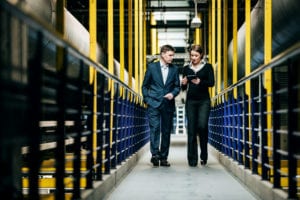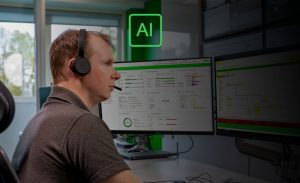The organizers of last year’s COP26 climate change conference pitched the event as our “last, best hope to save the planet”. But when the final gavel sounded, there was plenty of talk of “disappointment” and “failure.” Whether you share this sense of gloom, or welcome the important progress that was, in fact, delivered in Glasgow, one thing is clear: Throwing in the towel is simply not an option, regardless of what will the world look like in 2050.
Even if the goal of keeping the rise in global temperatures to 1.5°C now appears out of reach, we have to continue the climate change fight, to at least minimize the overshoot.
And that means focusing on delivering results well ahead of 2050, and decarbonizing both the supply side and the demand side of the energy equation.

Business action, advocacy and research are key to tackling global warming
As Chief Sustainability Officer for Schneider Electric, I have a front-row seat to this energy transition.
Our very business model centers on helping companies become cleaner and more energy-efficient, through tools that optimize energy management in buildings, homes, infrastructure installations, and industrial operations, and by offering sustainability advisory services.
We were among the first large companies to set ourselves ambitious sustainability targets, which we’ve continuously ratcheted up over the years. We’re a vocal advocate of climate change action in business and policy-making circles. And we conduct deep research and scenario planning on how best to tackle the climate crisis.
So I understand that the task ahead of us is massive. To put it in numbers: Decarbonization pledges at present equate to a total of up to 4 gigatons of energy-related CO2 emissions saved every year. That’s roughly a third of the 10-15 gigatons we should save each year by 2030 if we want to stand a chance of staying under the 1.5°C threshold.
We need to widen the spectrum of climate action…
The International Energy Agency estimates that as much as 80% of carbon emissions are energy-related. So we need to revolutionize how energy is generated, distributed and consumed.
The first two of these shifts are now well underway. Recent years have seen a huge increase in the amount of energy produced via clean, renewable technologies like solar, wind, biomass, and hydropower. Likewise, we’re now witnessing a rapid ramp-up of electrification in the automotive and other sectors. Combined with digital capabilities, this makes for what we refer to as “Electricity 4.0”.
The third piece of the puzzle — how energy is consumed – is less prominent on forecasters’ and policy-makers’ priority lists. Its potential as a decarbonization lever tends to be underestimated.
But addressing this demand side of the equation is critical if we’re to reach net-zero by 2050. Unless demand for energy stops rising, even a rapid shift towards clean energy generation and electrification won’t be able to eliminate our collective dependence on fossil-fuels.
The good news is that reducing energy demand is lower-hanging fruit than many realize. It entails boosting energy efficiency (what we call the “unsung hero” in the quest for net-zero) and circularity (sharing, re-using, repairing more materials and products) in factories, households, buildings, and entire economies.
None of this requires re-fashioning entire industries or inventing new ones from scratch. Technologies already exist to make new buildings that are hyper-efficient, and to renovate existing ones to sharply reduce their energy consumption.
…focus on the power of consumer demand…
What’s more, history teaches us that what drives energy transitions is not the simple availability of new technologies, but the appetite of users and consumers for the benefits those technologies bring. If demand materializes, the technologies will flourish. If not, they will languish.
This is a key point made in our own scenario modeling report, written by the Schneider Electric™ Sustainability Research Institute. This finds that we need to rebalance our efforts on demand optimization, energy supply decarbonization and electrification. That gives me hope that keeping global warming at least within the vicinity of 1.5°C may be more feasible than we think. And it gives me the motivation to keep working towards this goal.
The report presents a scenario under which consumer appetite for new technologies like autonomous driving, distributed clean-energy generation, building-efficiency tools, and intelligent EV charging stations helps to accelerate the transition to a less carbon-intensive economy – where the “pull” of demand speeds up the adoption of cleaner energy and more efficient products and services.
Past energy transitions have taken decades, rather than the mere years we have to work with. So policy makers and businesses need to urgently focus on this under-used catalyst.
Yes, supporting the development of alternative energy supply infrastructures is hugely important. But now it’s time to also focus on the demand side – to find ways to bolster consumer adoption of low-carbon technologies.
Done right, such a consumer-centric policy shift could help us reach a net-zero economy by 2050.
…and shrink our time horizons to act now, not tomorrow
But we also need action long before 2050. While that year is a key target date in most analyses and commitments, it’s important to act on the basis that to get to net-zero by 2050, we need to have lowered CO2 emissions by 30-50% by as early as 2030. We need to treat 2030 as a critical milestone along the 2050 trajectory.
COP26 may have left many of us hungering for even bolder commitments and bigger progress than it achieved. But that’s no excuse to throw our hands up in despair. We have plenty of tools with which to contain the worst effects of global warming. We need to use them quickly and fully, across the whole produce-distribute-consume spectrum.
What will the world look like in 2050 is uncertain but giving up is not an option. We still have everything to fight for.
Find out more about our Back to 2050 scenario in the executive summary.
Listen to the first episode of ‘Beyond the Scope’, Schneider Electric’s Podcast on Sustainability
In this first episode of Beyond the Scope, journalist, Sumit Bose, discusses with Schneider Electric’s Jeannie Salo, USA Government Relations VP, and Vincent Petit, Head of the Group’s Sustainability Research Institute, the actual impact of climate pledges post-COP26, the means to accelerate the energy transition and how private-public partnerships are playing a key role in it.
*****
Read some of my other blogs here:
- Being Part of the Climate Change Solution Means Going Beyond the Obvious – Now!
- Our Actions to Reverse Biodiversity Loss
- Looking back, looking ahead: our impact on sustainability
- Corporate action on climate change needed more than ever
- Why Providing Alternatives to SF6 and Other Greenhouse Gases is Important for Carbon Reduction Initiatives



